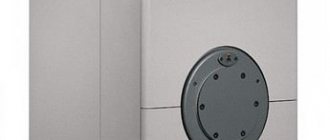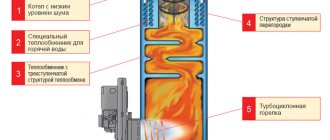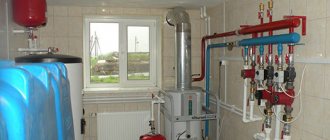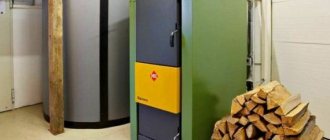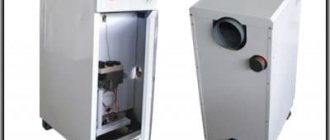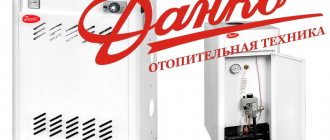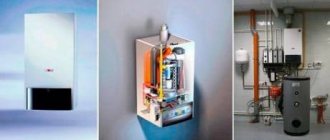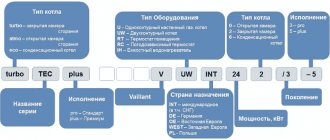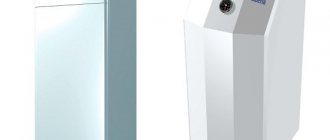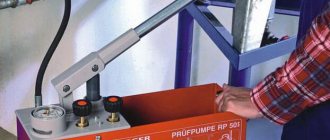Pellets
The compressed pellets, 6–8mm in diameter and up to 50mm in length, are made primarily from waste wood and are considered an environmentally friendly, renewable and carbon-neutral fuel. The granules are made without any kind of chemical additives. When burned, pellets emit more heat than wood, gas or diesel fuel. And at the same time, the price for them does not rise as catastrophically as for other types of fuel.
Pellets differ in their raw materials and the method of processing, which determine the color of the finished product. White pellets are obtained from wood waste. Gray - from a mixture of wood with bark and peat or seed husks. Black pellets are produced from the same raw materials, but by oxygen-free firing at high temperatures; their calorific characteristics are similar to coal, do not rot and are water-repellent.
Many boiler owners speak negatively about the quality of domestic pellets. Although it is difficult to rely only on reviews. Each region has its own producers of this type of solid fuel, and you can only find out what quality the pellets were after burning them. Even clean seed husks burn well and provide enough heat with the correct granule manufacturing technology. It is recommended to determine the approximate quality of granules by their appearance. They should be shiny, without cracks, at least 10 mm long, and not crumble into dust in your hands.
Pellet quality
External parameters
Heating with pellets is considered economical, but this only happens if you use high-quality pellets. Before purchasing a large batch, you need to burn a small volume in your boiler; this is the only way to accurately assess their quality. If this is not possible, some conclusions can be drawn from the appearance of the granules.
Pellets should be smooth to the touch with a minimum of roughness. A smooth surface shows that all important parameters were met during production. At the right temperature, the wood releases a natural adhesive called lingin, which when hardened reliably holds small particles together.
Hardness can be tested by trying to break a pellet. The more difficult it is to do this, the better the quality of the fuel. Also, the ease of destruction may indicate improper transportation, during which the destruction of particles began.
It is better to buy pellets packaged in bags. Thus, they are less likely to deteriorate during transportation. It is more reliable to take granules with a diameter of 6 mm, since they are produced on foreign equipment.
Pellets in bags
This type of fuel should have virtually no odor. A slight smell of the material from which it was made, for example, wood or seeds, is allowed. A rotten smell indicates improper storage, and a strong chemical smell indicates the use of unnatural adhesives in production. Color does not affect the quality of the pellets and depends on the source material.
Another easy way to check the quality is to dissolve a few granules in water. They must dissolve completely, otherwise it means the presence of synthetic additives. In this case, a large amount of heavy sediment should not appear, which indicates a high degree of ash content.
Quality classes
In Europe and the CIS, a general labeling standard ENplus has been adopted, which indicates the parameters of pellets. It regulates the ban on the use of chemicals in production and the standard size of granules: 40 mm in length and 6 mm in diameter. The moisture content should not exceed 10%.
There are three quality levels:
- Class A1. Made from coniferous and deciduous wood. Permissible ash content is from 0.5% to 0.7%. Most are used for domestic boilers.
- Class A2. The raw materials for them are mixed wood species. The ash content reaches 1%.
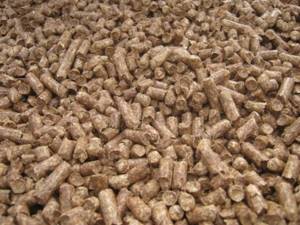
Mixed wood pellets - class A2 - Class B. The third class is used in large industrial production and has an ash content of up to 3%.
Also, companies that have received this certificate guarantee a high level of quality in product transportation. And this is extremely important, since if transported incorrectly, pellets absorb moisture and their efficiency level decreases significantly.
Pellet boilers
Solid fuel boilers, which use pellets as fuel, are used for heating private houses and small public buildings and heating water.
Modern automation allows you to maintain a comfortable temperature in the room, which can be set depending on the time of day and season. Wood pellets are fed from the hopper to the firebox as needed using a special auger, which is controlled automatically. When the set temperature is reached, the auger stops and the granules are not fed into the firebox. Typically, the volume of the bunker allows you to store a supply of pellets for several days. If you can organize a warehouse for storing pellets, from which they are immediately supplied to the bunker, then the process becomes more convenient . Experts recommend using a pellet boiler in combination with a backup device using another heat source, most often electricity. But today there are models on the market that can, if necessary, work with both wood and briquettes.
According to consumer reviews, which have something to compare with, in terms of requirements for location, installation and safe operation, pellet boilers are no different from gas or liquid fuel devices. Modern models are quite compact, differ from analogues in the small volume of the combustion chamber and a special burner with high efficiency. They are also characterized by a service life of up to twenty years (at least according to the instructions) and a high level of automation.
Manufacturers claim that if there is a special warehouse with a pellet supply system, the device can operate without human intervention throughout the entire heating season. According to reviews, an autonomous feeding system requires careful installation and precise adherence to geometry, otherwise granules will get stuck at the bends of the pipes, disrupting the smooth operation of the system.
Pellet boilers are available in various capacities, from 15 to 100 kW .
Manufacturers recommend determining the required boiler power at the rate of 1 kW per ten square meters of area plus fifteen percent for the heat loss of the house. Reviews from owners of country houses confirm these data. Since houses are built and insulated for domestic winters, even without a margin of fifteen percent, the temperature in the rooms is maintained at a comfortable level.
Review of Russian manufacturers
Let's look at Russian pellet boilers:
Obschemash supplies the market with Russian-made Valdai and Peresvet boilers and burners that can be installed on an already operating heating system. Boilers are supplied to the market with different capacities. Devices controlled via wi-fi cost 10-20 thousand more.
“Valdai” was designed specifically for pellets, but heating with wood is also possible, as an emergency option.

Pellet boiler Pelletron
“Peresvet” accommodates three times more firewood in the combustion chamber and can be considered universal.
“Zota Pellet” – Domestic boilers with the ability to control remotely via SMS. Unpretentious to the quality of fuel, it can consume both firewood and fuel briquettes and pellets.
Advantages of pellet boilers
Pellet boilers have undoubted advantages:
- Pellets are by far the safest fuel when compared to gas and electricity. But no one mentions such a positive aspect, and, most likely, because no one had any problems in this regard.
- Significantly reduce heating costs compared to electric ones. They have been actively used in Russian realities for several years now, and the reviews of their owners can be trusted. These are not theoretical calculations from foreign sources, but a statement of fact. Some say the costs are reduced by half, others by thirty percent (if you use a two-tariff meter) compared to electric heating devices. With regard to gas, the situation is the opposite. But gas is not available everywhere, and even gas cylinders are not always available. And gas is an explosive substance, unlike pellets.
- High efficiency up to 95% . Manufacturers talk about 97% in some models.
- Availability of an additional hot water supply circuit.
- Pellets are convenient to transport and store, they do not cause allergic reactions, are environmentally friendly and non-toxic. The only requirement for the room for storing them is dryness.
- Pellets are becoming more affordable every year. Today there are already many enterprises producing wood pellets. If several years ago consumer reviews spoke of a shortage of such fuel and the need to stock up on it from the summer for the entire heating season, now the excitement has subsided, and no one sees the need to store ten tons of fuel at once.
- The price of pellets is more stable than electricity or gas tariffs, and now that more and more of them are being produced, its seasonal fluctuations are not so noticeable.
- Heating a country house using a pellet boiler does not require approval for connection and operation; if desired, the equipment can be installed independently.
- Ash after combustion of pellets consists of natural minerals, and there are no problems with its disposal, as their owners have repeatedly noted on forums.
Disadvantages of pellet boilers
It would seem that pellet stoves have so many advantages that they should already be in every country house, but the disadvantages get in the way:
- Quite a high price. It has been declining in recent years, but still exceeds the cost of gas and electric analogues. The cost of a pellet boiler is twice as high as a gas boiler of the same power. But there are separate burners that can be installed in an existing solid fuel boiler.
- Need for constant care . Throughout the heating period, almost every week you need to clean the heat exchanger with a special brush and remove ash from the ash collector. True, this applies to outdated models. Modern devices have an automatic cleaning function. And the frequency of such work directly depends on the quality of the pellets. This drawback is noted by all owners of pellet stoves.
- If there is no warehouse with automatic supply of pellets, the bunker must be loaded manually at least once a week, depending on its size. But this is a common drawback of all solid fuel devices.
- The need for a sufficiently large dry room for storing pellets. Even for the smallest 10 kW boiler, according to reviews, 2 kg/hour or 2 bags of 25 kg of pellets per day are required, that is, about one and a half tons of pellets are needed for a month, and they need to be stored in a dry room or a large container. True, the environmental safety and absence of odors in pellets allows this volume to be used for other purposes in the warm season.
- In remote areas, there may be complications with the purchase of high-quality pellets, their delivery and servicing of imported equipment, which, to be honest, was not designed for the harsh Russian winters and the quality of the fuel.
How to calculate pellet consumption
The calculation is carried out in several stages, although in general it is quite simple. Its result should be the average monthly fuel consumption of a pellet boiler during the heating season and the average cost of such heating. For clarity, we will look at an example calculation for a 100 m² house.

The torch-type burner automatically ignites and goes out at the command of the controller, this allows for significant fuel savings
Stage one. First you need to understand how much heat actually enters the heating system when burning 1 kg of fuel pellets. After all, heating equipment is not so perfect as to direct all the energy received to heat the house; part of it will fly out into the chimney. To do this, the combustion heat of the granules should be multiplied by the efficiency of the heat generator, divided by 100:
5 kW/kg x 80% / 100 = 4 kW/kg.
Stage two. For ease of calculation, you need to do the opposite to find out how many pellets you need to burn to obtain 1 kW of thermal energy in real conditions:
1 kW / 4 kW/kg = 0.25 kg.
Stage three. During the heating season, the weather outside changes and the temperature ranges from +10 °C to -30 °C. The average specific heat consumption for the entire season for a house of 100 m² will not be 10 kW, but half as much - 5 kW. Considering that power units are assigned to a time of 1 hour, the heat consumption per day will be:
5 kW/h x 24 hours = 120 kW.
The same, only for a month:
120 kW x 30 days = 3600 kW.
Stage four. Now it is easy to calculate the average consumption of pellets per month for a building of 100 m² during the entire heating season:
3600 kW x 0.25 kg/kW = 900 kg.
If the cold season lasts 7 months, as in Moscow, Russian Federation, then the total amount of fuel pellets for heating a private house with an area of 100 square meters will be 900 x 7 = 6.3 tons. The average monthly consumption of pellets for a house with an area of 150 and 200 m² is determined in the same way; it is equal to 1.35 and 1.8 tons, respectively. Since pellets are sold by weight and not by volume, there is no need to convert this quantity into volumetric units.
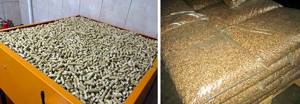
Those who are interested in the approximate consumption of wood pellets on average per day can calculate it in this way (for our example):
120 kW x 0.25 kg/kW = 30 kg.
Attention! The average calculated value should not be confused with actual fuel consumption on the coldest and warmest days. In a building of 100 m² it can vary between 15-60 kg of pellets per day.
To get approximate costs for pellet heating in monetary terms, you need to multiply the obtained figures by the price per ton accepted in your region. At prices in the capitals of the Russian Federation and Ukraine, monthly heating costs for a private house of 100 square meters will be:
- for Moscow: 0.9 t x 8500 rub/t = 7650 rub;
- for Kyiv: 0.9 t x 3000 UAH/t = 2700 UAH.

It must be taken into account that we carried out an abstract calculation; in the conditions of Ukraine, financial costs for pellet heating will be lower due to the milder climate.
Leading manufacturers
There are now devices from Russian and foreign manufacturers on the market.
Russian-made boilers
Despite the fact that most owners agree that they have more disadvantages than advantages, Russian pellet makers are produced by several serious enterprises:
- It is worth highlighting “Oranges” produced by NCC Biyskenergoproekt, which got their name for their bright color. They are characterized by an optimal price-quality ratio and an efficiency of 93% with ease and reliability of use. "Orange" is equipped with electronic control, automated fuel loading and forced ventilation. Focused on the domestic pallet market with their quality. At the same time, the cost of “Oranges” is on average 150 thousand rubles.
- Start boilers are manufactured in Chelyabinsk, however, they are equipped with Polish volumetric combustion burners, which allow complete combustion of fuel and high efficiency. “Start” is a combination boiler and, in addition to pellets, can operate on coal, wood, and small chips. For this purpose, the kit includes a cast iron grate, which is installed instead of the burner. Price ranges from 130-250 thousand rubles.
- The Krasnoyarsk Zota Pellet consumes various types of fuel; its functions include the ability to control the heating process using SMS messages. The line includes five models with a power from 15 to 100 kW, which are used in closed heating systems (with forced circulation). According to reviews, they functionally correspond to the Finnish Auterm Biomatic, but are half the price, and the Grandeg models of the same price category are one step lower in function.
- Pellet boilers "Kupper" LLC "Teplodar" from Novosibirsk, whose power ranges from 10 to 40 kW, are converted conventional solid fuel boilers with a pellet burner. Owners note its low price of about 80 thousand rubles depending on the model, the difficulty of setting up, the need to select high-quality pellets and minor modifications such as grinding the auger bolt (it protrudes very much, because of this the pellets get stuck in the hopper).
Our village is small, they promised to supply gas in three years. I wanted to install solid fuel heating, but there was nowhere to store firewood and no time to do it. Service technicians will not come to us, so I chose a boiler from a serious specialized plant. I chose “Kupper” , which is one and a half times cheaper than other manufacturers of the same power. With the difference in price, I will be able to heat a 100 square meter house for just two years.
Fedor Mikhailovich
Review of imported manufacturers
“Termal” (Macedonia) – pellet fireplaces and boilers are very impressive, some models are suitable for installation directly in a living space. Production has also been established in our country.
“Termodinamik” (Turkey) – quality at an affordable price. In addition to pellets and other solid fuels with particle sizes up to 25 mm, boilers are fired with wood and coal.
“Froling” (Austria) - the manufacturer promises ideal performance and stable temperature, which is logical to expect for 700 thousand rubles. Includes all necessary heating systems and hot water supply. Wall-mounted models take up very little space.
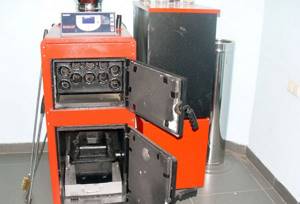
Pellet boiler Termodinamik EKY/S
“Distand” (Austria) - budget equipment from a European manufacturer, equipped with dual-circuit weather automatics.
“Klover” (Italy) – presents a wide selection of pellet fireplaces and thermal kitchens for installation both in residential premises and in individual boiler rooms. Combination stoves for simultaneous combustion of wood and pellets.
Pellets are an inexpensive and efficient fuel. Build a pellet boiler with your own hands and see for yourself.
Read the link for tips on choosing a wall-mounted heating boiler. Main characteristics and prices.
In what cases should you choose a single-circuit gas boiler for heating a house and how to choose and install it correctly, read this article:. Detailed information about gas boilers.
